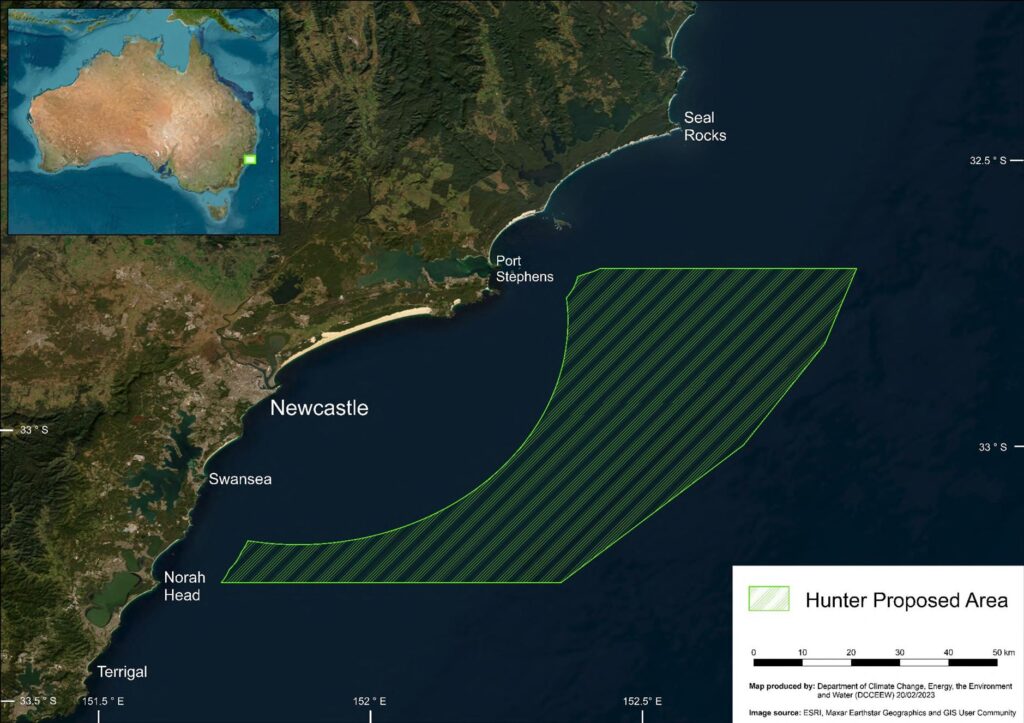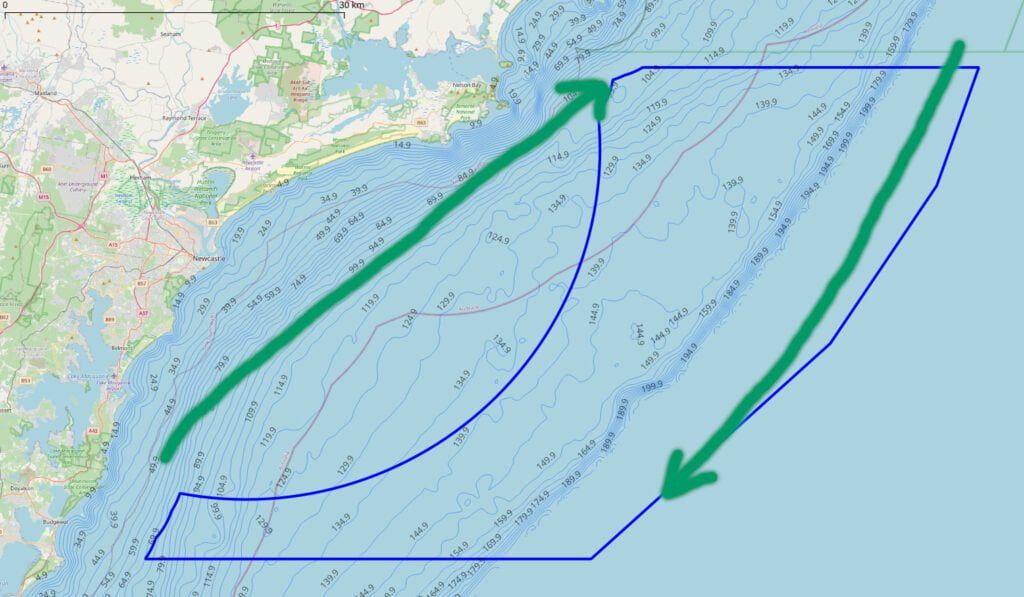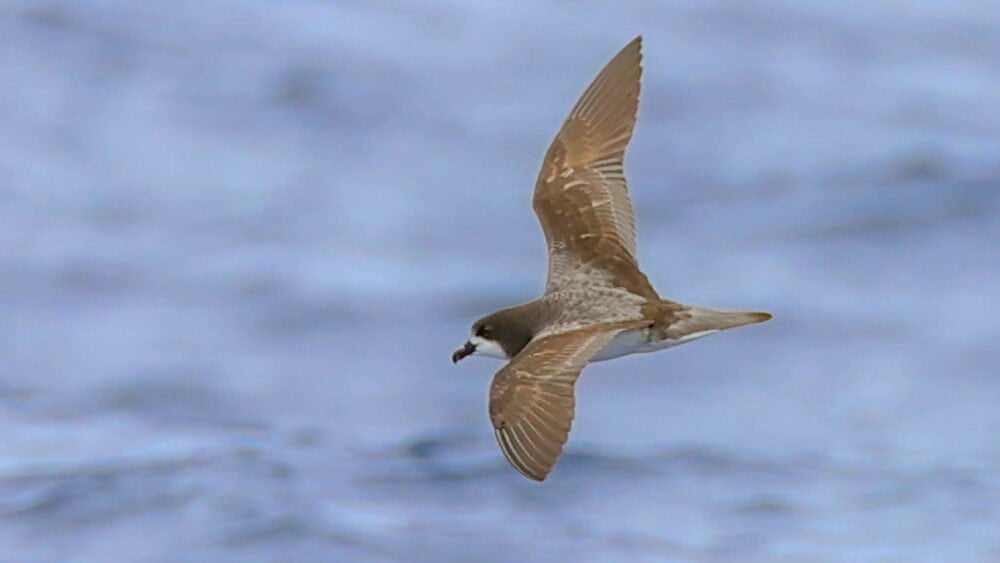Proposal for offshore wind projects off the Hunter
by Iain Watt, President EcoNetwork Port Stephens.

Source: Australian Government
The Minister for Climate Change and Energy has proposed an area in Australian Commonwealth waters off the Hunter region for offshore renewable energy projects. This includes offshore wind.
Despite a well-developed offshore wind industry (OWI) in Europe and other parts of the world, it is relatively new to Australia where the Offshore Electricity Infrastructure Act 2021 and the Offshore Electricity Infrastructure (Regulatory Levies) Act 2021 only commenced in June 2022. There is a risk that the whole operation is moving forward with unseemly haste.
Wind power is recognised globally as one of the most cost-effective method of power generation, exceeding that of coal and nuclear. Development costs have decreased by 50 % over the past decade and the industry has demonstrated in Europe that it can compete with other generation methods without subsidies. However, onshore wind generation remains considerably cheaper at around 50% the cost, but comes with more environmental and social angst.
Companies such as Electricite de France, BP and Norwegian conglomerates are not small players in the corporate lobby world. With the corporate sector driving offshore wind development, largely to maintain control on centralised power generation, there is no guarantee that it will deliver cost benefits to the community.
The risk that the environmental and social impacts of these developments will be undermined for posterity, jobs and profit, remains a real concern. It will be incumbent on the government of the day to ensure that controls are not circumvented.
Shipping, coal port and vessel movements
An offshore services industry based in Port Stephens will result in increased vessel movements, operating alongside a vibrant and important marine tourism industry that is dependent on a healthy marine environment and interaction with dolphins, whales, and seabirds, will not make good bedfellows. At the least, increased traffic in the Port will have to be carefully managed.
This development could potentially generate economic benefits and a range of employment opportunities for Port Stephens. Most of the opportunities will likely centre around the area to the south, off Newcastle as the industry hub. But given the scale of proposed offshore developments there is an obvious and existing national and state-wide gap in training opportunities in the marine education research and industry sectors. Port Stephens has the potential capacity to benefit from filling this gap.
The area most appropriate for this development, would be the southern section of the lease, off the industrial hub of Newcastle. This area is relatively close to shore and access to the existing national grid mitigating the need for constructing new high voltage transmission lines.
This area is also the holding ground for the coal ships waiting to enter the Port of Newcastle, the busiest port in Australia (see Map 1), with more than 1000 ship movements per year. There can be between 30 – 50 vessels waiting off shore, close to and adjacent to this area, particularly during bad weather when they are unable to enter port. The combination of many coal vessels and bad/severe weather would increase the risk of a catastrophic collision between one of these vessels and a turbine. This situation is unlikely to change until Newcastle Port has largely transitioned from a coal port to an offshore wind services port.

Severe offshore weather may impact on the infrastructure. However, most of this industry appears to be migrating from the North Sea where a significant wave height of 14 – 15 m is experienced with the maximum recorded at 25.6 m in 1995, the current known world record. The significant wave heights off NSW, measured by wave buoys over 35 years are 8 – 9 m with a maximum recorded off Sydney of 12 m.
Ecological footprint during construction phase
When considering wind power for sustainable power generation, its ecological footprint is critical to its credibility. With a willingness to collaborate and work together on resolving potential environmental and social impacts and with the necessary research funds, equitable solutions can no doubt be found.
Most impacts have been shown to occur during the development phase (seabed testing) and the construction phases of offshore wind farms (OWF). This will involve positioning platforms and anchoring them to the seabed, dredging and laying in transmission and interconnection lines and the construction of subsea distribution substations and running large offshore transmission cables ashore.
This will generate considerable disturbance within the leasehold, including increased turbidity and noise levels which may have an impact on animals such as whales, dolphins, seals, turtles, sharks etc. Studies from Europe and elsewhere have shown that impacts after the construction phase are considerably reduced but intense service vessel movements potential impacts will continue to be high.
Marine life
An obvious conflict with this development is that the Hunter Region lease spans the east coast whale highway. Tethered installations, anchor cables and transmission lines descending from the installation to the seabed are potential collision threats for transiting whales. There are indications from other parts of the world that impacts have been mitigated through careful design and layout of the windfarms. However, these international findings will have to be verified in the local context and construction methods.
The construction phases will potentially disrupt the annual winter humpback migration, estimated at 30,000 to 40,000 animals. This risk can be mitigated or reduced by careful planning to restrict offshore work to the summer months and avoid the peak winter migration period.
Map 2 shows that the main northerly migration passes nominally in shore of the proposed lease. The southern migration apparently largely follows the Eastern Australian Current and the drop off. These are likely to be mature males, adolescents and non breeding females, while a significant number of animals mainly mothers and calves travel closer to the shore and possibly through the lease area during the southern migration. These animals support the whale watching industry through the winter.
The Hunter OWF lease also straddles the flyway of migratory and pelagic sea birds along the eastern seaboard of NSW. Sea birds tend to breed in colonies and use the coastal waters for foraging and migration routes. As a result, populations and breeding colonies tend to be concentrated during certain times of the year.
There are conflicting reports on the impacts of wind farms on pelagic and migratory seabird populations. Monitoring of an OWF in Denmark over several years showed negligible impact on seabird populations and indicated that most seabirds changed direction to avoid flying through the area. While this mitigates collision with turbines, it still represents a loss of foraging habitat.
However, this is very dependent on the species native to the area, and other studies in UK showed that the population of sandwich terns around one OWF was reduced by 35% over a relatively short time indicating potential impacts from collisions with turbine blades can be high.
58 species of seabirds including rare visitors have been recorded in the Hunter Region, 38 of which are truly pelagic birds. The offshore islands of Port Stephens, to the north of the lease are important breeding colonies for the wedge-tailed shearwater and the threatened Gould’s Petrel with its primarily breeding site on Cabbage Tree Island and is known to migrate south, through the lease area. The short-tailed shearwater also migrates through this area in flocks of tens of thousands flying around the same height as the turbine blades.
Clearly further research is required to develop spatial planning and a better understanding of the sensitivity of local sea bird and their use of the area. This is particularly relevant given the potential growth of the offshore wind industry and the overlap that will inevitably arise between the existing seabird populations and the expanding offshore wind industry. Further studies are required to verify local conditions and should be undertaken both prior to the construction and continued during the operational phases.
Fish and fishing
Some wind farm infrastructure has been shown to act as artificial reefs, providing protection and structure for settlement of a range of organisms that in turn attract fish developing a rich offshore biomass and biodiversity. Studies in Denmark and elsewhere have shown up to a 60 fold increase in food availability for fish and other organisms in the wind farm areas. Studies of cod and Atlantic salmon indicate they can detect offshore turbines from considerable distances, depending on the wind speeds.
Impacts on fish populations may be recorded during the construction phases. Fish produce a variety of sounds for communications, which may be masked by construction noise decreasing the effective range of communication and orientation and mating signals. However, there is no evidence of long-term impacts to fish populations nor damage to their hearing organs. There is clearly a need for further studies to determine any local impacts and other ecological conditions associated with these developments on fish populations.
Conflicts between commercial fishers and OWF in European waters have resulted in spatial exclusions for certain types of fisheries. This development will sit astride important commercial fishing grounds for the Hunter area. The Newcastle and Port Stephens Commercial Fishing Cooperative estimates that up to one third of the local commercial fishing grounds could be lost through this development, putting the livelihoods of the fishers and the future of the Cooperative at risk. Considerable conflict can be expected between the regulatory bodies, the operators and the commercial fishing industry. Apparently recreational fishers will be able to access these areas, but this is highly unlikely as these areas will probably be designated exclusion zones for security purposes etc.
Visual amenity is a major concern for some local residents and tourism operators. The proposed distance offshore will determine the level of impact OWFs will have on visual amenity. If the wind farm is placed to the south of the lease off Newcastle, they will have minimal visual impact from Port Stephens. But from high points such as Tomaree Head, they will likely be visible on the horizon, not unlike the existing coal ships.
Conclusions
While there may be advantages to the development of the offshore wind industry off Port Stephens, there remain serious questions to be answered. Globally, offshore facilities at this depth are mainly the subject of feasibility studies and concept planning using as yet untested technologies. This will require blue sky research as well as considerable support and funding from the federal and state governments and primarily no strings funding from industry.
With this week’s release of the IPCC report and with power stations in the Hunter rapidly closing, any proposed offshore renewable projects such as wind turbines or wave energy are too far off. Rolling out existing renewable technology without further delay has to be the focus and priority for government.
If you would like to make a submission, the process is available using the link below.
More information and how to make a submission
The Minister for Climate Change and Energy has proposed an area in Australian Commonwealth waters off the Hunter region for offshore renewable energy projects including wind. Consultation documents are available and you can provide your feedback by answering specific questions or include a detailed written submission if you prefer.
Have your Say on the Consultation Hub by Friday 28 April 2023.



